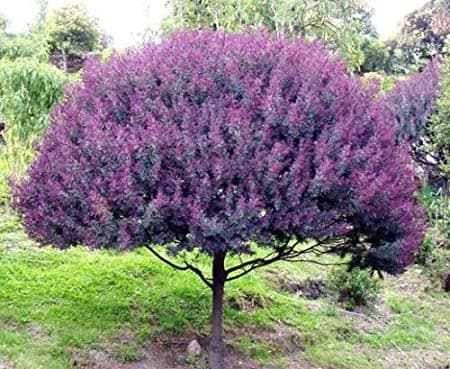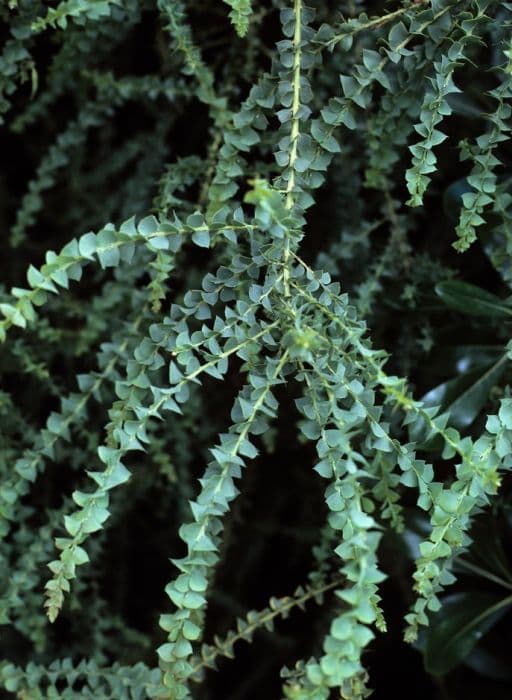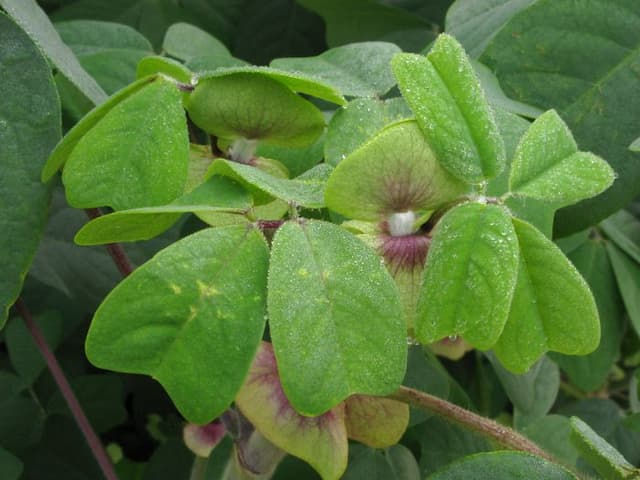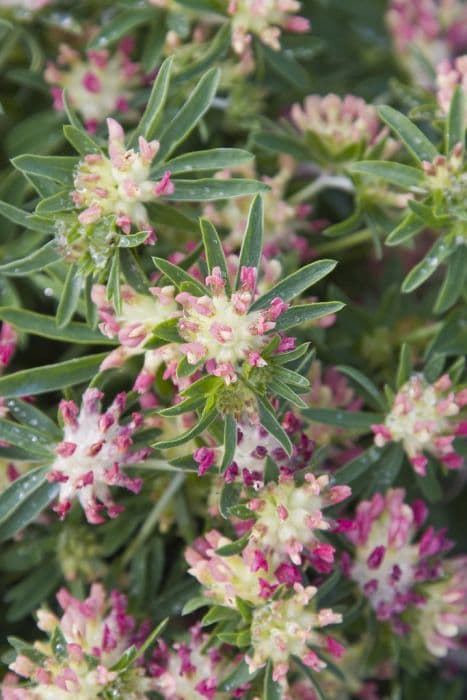Black pea Lathyrus niger






ABOUT
L. niger is an upright perennial, to 90cm tall, with robust, wingless, branched stems and leaves comprising 3-6 pairs of elliptical leaflets up to 4cm long and lacking tendrils. Purplish flowers, that turn blue as they age, are borne in sprays of four to ten in late spring and early summer and are followed by black pods carrying 6-8 seeds. The plant derives its name from its foliage which turns black as it dies
About this plant
 Names
NamesFamily
Fabaceae.
Synonyms
Black Pea, Black Peavine, Black Vetchling.
Common names
Orobus niger, Lathyrus montanus, Lathyrus sylvestris, Orobus angustifolius.
 Characteristics
CharacteristicsLife cycle
Perennials
Foliage type
Deciduous
Color of leaves
Green
Flower color
Purple
Height
2-3 feet (60-90 cm)
Spread
1-2 feet (30-60 cm)
Plant type
Herb
Hardiness zones
5
Native area
Europe
Benefits
 General Benefits
General Benefits- Nitrogen Fixation: Lathyrus niger, commonly known as black pea, contributes to soil fertility by fixing atmospheric nitrogen through a symbiotic relationship with soil bacteria.
- Biodiversity Support: Provides habitat and food for various species of insects, thus supporting local biodiversity.
- Erosion Control: The root systems of black pea can help stabilize soil and prevent erosion in the areas where it grows.
- Aesthetic Value: Offers natural beauty when in bloom, with its flowers providing a pleasing visual in gardens and natural settings.
- Wildlife Nutrition: Can be a food source for wildlife such as birds and small mammals that consume its seeds or foliage.
 Medical Properties
Medical PropertiesThis plant is not used for medical purposes.
 Air-purifying Qualities
Air-purifying QualitiesThis plant is not specifically known for air purifying qualities.
 Other Uses
Other Uses- The seeds of the Black pea, when ground, can be used as an alternative flour for baking, as long as they have been properly processed to remove toxicity which can cause lathyrism.
- Insecticidal properties of the Black pea have been noted, with its extracts sometimes used in organic gardening to deter certain pests.
- The stems of the Black pea have been historically used to make rough twine or cord, given their fibrous nature.
- Due to its fibrous stems, it can be utilized in the paper-making industry as a pulp ingredient for a certain type of paper.
- Companion planting with Black pea may benefit vegetable gardens by providing natural shade for cooler-temperature crops.
- Its dense growth habit can help with soil erosion control on sloping gardens or fields.
- The stems and leaves, when dried, can serve as a filling material for mattresses or upholstered furniture in traditional crafting applications.
- Black pea plants can be used in a rotational cropping system to improve soil nitrogen levels because it is a legume.
- When dried, the flowers of the Black pea could potentially be utilized in potpourri for their aesthetic appeal.
- Black pea stems have been used historically as a source of natural dye, though the color fastness and intensity are typically mild.
Interesting Facts
 Feng Shui
Feng ShuiThe Black Pea is not used in Feng Shui practice.
 Zodiac Sign Compitability
Zodiac Sign CompitabilityThe Black Pea is not used in astrology practice.
 Plant Symbolism
Plant Symbolism- Hardiness - Lathyrus niger, commonly known as the Black Pea, reflects a sense of hardiness and resilience as it can thrive in a variety of conditions.
- Protection - In folklore, Black Pea was believed to offer protection against negative forces, possibly due to its robust nature.
- Strength - Analogous to its ability to grow in tough environments, the Black Pea symbolizes inner strength and the capacity to withstand challenges.
- Mystery - Its dark coloration can represent mystery or the unknown, hinting at hidden depths or secrets.
 Water
WaterThe Black Pea plant requires regular watering, especially during the growing season. It prefers to be kept evenly moist and not overly saturated. Water the Black Pea when the top inch of soil feels dry to the touch, which typically means watering once every week, with about 1 gallon per plant. In hotter, dryer periods, this may increase to twice a week, especially if the plant is in a well-draining soil which tends to dry out faster. During the dormant season or cooler months, reduce watering frequency to prevent root rot as the plant's water requirements diminish.
 Light
LightThe Black Pea plant thrives in full sunlight to partial shade. It is best situated in a spot where it can receive at least six hours of direct sunlight daily, but can also tolerate some light shade especially during the hottest part of the day. The ideal spot for the Black Pea plant is one where morning sunlight is abundant and intense afternoon sun is somewhat filtered.
 Temperature
TemperatureBlack Pea plants prefer moderate temperatures and are cold-hardy. The ideal temperature range is between 50°F and 70°F. They can tolerate temperatures as low as 40°F and as high as 80°F without significant stress. Extended exposure to temperatures outside of this range, particularly freezing temperatures under 32°F, can damage the plant.
 Pruning
PruningBlack Pea plants should be pruned to encourage bushier growth and to remove any dead or damaged stems. The best time for pruning is in late winter or early spring before new growth begins. Lightly prune the plant after flowering to maintain its shape and to remove spent flowers, which can promote a second bloom. Pruning should be done annually.
 Cleaning
CleaningNot needed
 Soil
SoilBlack Peavine thrives in well-draining soil with a pH between 6.0 and 7.5. A good mix would be loam, compost, and sand to ensure adequate drainage and fertility.
 Repotting
RepottingBlack Peavine should be repotted every 1-2 years when the root system outgrows the pot or the soil degrades, to maintain its health and vigor.
 Humidity & Misting
Humidity & MistingBlack Peavine prefers moderate to high humidity levels but is adaptable to average household humidity settings.
 Suitable locations
Suitable locationsIndoor
Ensure bright, indirect light and consistent moisture.
Outdoor
Plant in semi-shade, shelter from strong wind.
Hardiness zone
5-9 USDA
 Life cycle
Life cycleThe life of the Black Pea (Lathyrus niger) starts with seed germination, usually occurring in spring when the soil warms up. Upon germination, a seedling develops, growing a root system and a shoot that emerges above ground. The plant then enters a vegetative stage, forming compound leaves with leaflets and tendrils that enable it to climb. Following this, Lathyrus niger progresses to the flowering stage in early summer, displaying white to purple flowers that are pollinated by insects. Successful pollination leads to the development of pods, which contain the seeds; these mature by late summer and, once dry, the pods release the seeds, completing the reproductive cycle. The plant is perennial, so it survives year to year, going dormant in winter before resuming growth in the next spring.
 Propogation
PropogationPropogation time
Spring-Early Summer
For the Lathyrus niger, commonly known as the Black Pea or Black Peavine, the most popular method of propagation is by seed. The best time to sow Black Pea seeds is in early spring, just after the risk of frost has passed, which allows for maximum growing season. Seeds should be sown directly into a well-draining soil that is rich in organic matter, ideally in a sunny location. Prior to planting, it is beneficial to nick the seed coat or soak the seeds in water for 24 hours (approximately 1 ounce or 29.6 milliliters) to improve germination rates. Sow the seeds at a depth of about 1 inch (2.54 centimeters) and space them approximately 2 to 3 inches (5.08 to 7.62 centimeters) apart. Water the soil gently but thoroughly after planting, and maintain consistent moisture until germination occurs. Once established, Black Pea plants require minimal care, but staking may be necessary for support as the vines grow.









